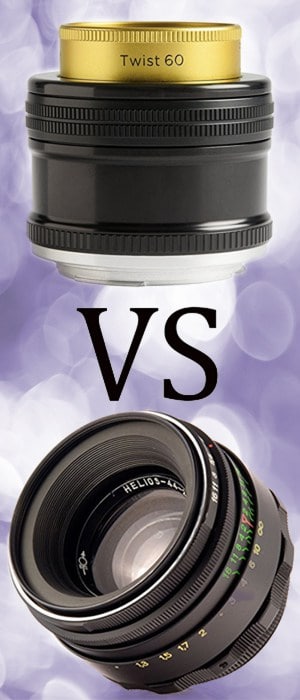
Bokeh refers to the way a lens handles points of light that are not in focus. From well-defined starbursts at f16 or higher, down to big, soft, blurry balls at f2.8 or lower, a lens is judged on how well these effects please the eye. Most of the big players in the lens manufacturing world are focused on creating the softest, roundest, creamiest blur possible when their lenses are used with a wide open aperture. A few dare to be different, striving for a surreal, swirly blur effect that creates a unique, “down the rabbit hole” mood. Of course, these are the ones that interest me. Different always interests me.
History
First, there was the Petzval lens. In 1840, it was by far the fastest lens of the time, with an aperture of f/3.6. It was a game changer in the portrait photography world, up until then exposure times of a minute or longer were the norm. The lens created a characteristic swirly blur and heavy vignetting around the edges. In recent years, the folks at Lomography have created a modern day copy of the Petzval lens, but it will set you back a pretty penny and I have not personally had my hands on one.
(As a morbid and fascinating aside, check out Memento Mori Photography. I'm not going to provide a link, because it may be disturbing for some readers – you've been warned! It was the Victorian practice of photographing deceased people. Because photography was so expensive, many people died before ever having a portrait made of them. That didn't stop our Victorian forebears, they built special stands to prop their dead up and photographed them, often with surviving relatives, as though they were still alive! This is relevant to the current discussion only because of the aforementioned long exposure times. One of the ways you can identify a memento mori photograph is if one person in a photo from that period appears completely tack sharp…that is the only subject that didn't move, at all, for a full minute or more! Thanks, Josef Petzval, for making photography so much faster. Thanks, Victorians, for ensuring we never run out of nightmares.)

Affordability
Back to the battle at hand, a much more affordable way to experiment with the swirly blur effect is with the Lensbaby Twist 60. You can read my full review of this quirky and super fun lens, here. Another is by finding an old, Russian Helios 44-2 lens. This is not difficult because they made millions of these lenses from the mid to late 1900's. They were modeled after the comparatively rare Zeiss Biotar 2/58 lens, circa the 1920's. You can easily find the Helios on eBay, converted for a variety of camera mounts. I purchased mine from this seller and was very happy with the quality and how quickly it arrived. He even makes an autofocus version, although I have not tried it out. You should be able to find one of these lenses for well under $100, even with a converter for your camera's mount. The affordability point goes to the Helios 44-2. In fact, it is so affordable, for a well built, sharp prime lens, that you're crazy if you don't grab one.
(No, I am not affiliated with the eBay seller in any way, I paid full price for my lens and neither I nor Improve Photography receive any affiliate commission if you purchase from him. I just think that the barrier to purchase one is so low, this fun and quirky lens should be in everyone's bag.)

Mount
The Helios was made with an M42 mount but can be used with adapters to fit it on most modern cameras. One note if you are purchasing a Helios 44-2 with a Nikon mount – it will need to be modified, or you will not be able to focus to infinity. You may not care since the point of using a lens like this is to focus on something fairly close and have a good distance between your subject and the background. (That is the best technique for achieving the desired swirly blur effect). I purchased my lens with the modification and it works well, you can also find instructions online for modifying the lens yourself. Although both lenses are available in a variety of mounts, the point will have to go to Lensbaby. The Lensbaby Twist 60 doesn't have a converter between your lens and the mount, it is made for the different mounts and will work equally well with all of them.
Consistency/Reliability
When you buy a Helios lens, it has almost certainly been used. Even new, there can be a wide range in quality. They were produced very inexpensively, by the millions. Quality control was not a big priority. There is a certain amount of chance involved and not all sellers may be scrupulous. You are not going to receive a warranty with your Helios lens, and you will likely be buying from a seller in Russia or the Ukraine. If there is an issue, it may not be so easy to get your money back. Make sure to check the seller's reviews and ratings. This is another point in favour of Lensbaby. You know what you are getting.
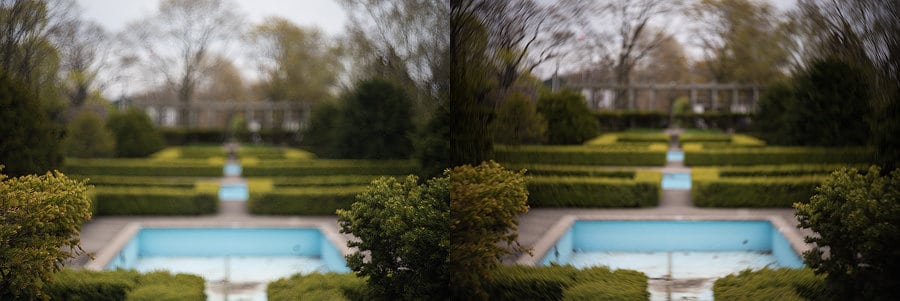
Availability
I'm going to give this point to the Helios because its mass production means you can always find it. The Lensbaby is usually available, but I have known it to be on back order on occasion.
Build
While the lenses are similar in size, the Helios is a much more solid piece of glass and metal. Although it is quite small, it feels as though it might survive a fall onto a tile floor and possibly chip the tiles. The Lensbaby Twist 60 is several steps up in quality from some of the original Lensbaby lineup, but it still seems a little flimsy next to the Helios 44-2.
Weight
Being solid is great, but being heavy is not. Although neither of these lenses is so big and heavy that it will cause you back problems, the Twist 60 is a little bit lighter, at 221g (0.49 lbs). The Helios 44-2 weighs 230g (0.51 lbs), but will probably have the added weight of a converter for your camera mount. They are close enough that it won't likely affect your choice, but the point goes to Lensbaby by a hair.
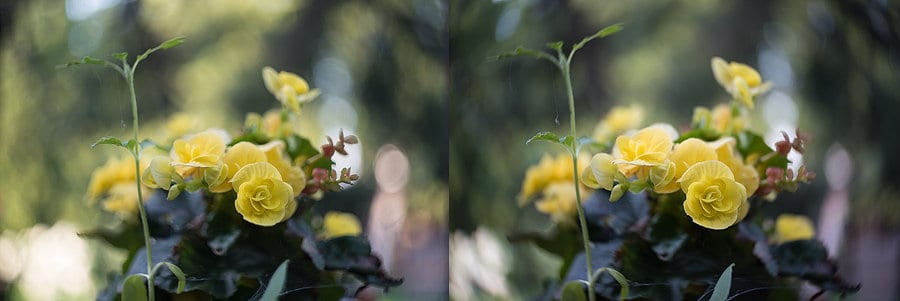
Aperture
The Helios has an 8 bladed aperture that goes from a maximum of f/2.0 to a minimum of f/16. The Lensbaby has a 12 bladed aperture that goes from f/2.5 to f/22. I give the point to the Helios on this one, since I don't really care about the minimum aperture on a specialty lens like this. The Helios lets in a little bit more light when wide open and creates a little bit softer bokeh, that's what matters to me.
Focal Distance
The minimal focal distance on the Lensbaby Twist 60 is 45 cm (18 inches). The Helios is closer to 49.5 cm (19.5 inches). I give this point to the Lensbaby because the slightly closer minimal focusing distance combined with the slightly longer focal length (60 mm vs 58 mm) may serve to give you that extra bit of blur and separation from your background.
Focusing
Both of these lenses are manual focus, and both are sharpest in the center. Because they both have manual apertures, you may have to switch to live view in order to focus when using them stopped down. (When the aperture is controlled by the camera, it is kept wide open while you compose and focus and snaps shut only when you press the shutter button. When you change the aperture with a dial on the lens, you are letting in less light and the image through the viewfinder will become darker. Most modern cameras show the image from the sensor on the live view, rather than the image from the viewfinder, so it will appear much brighter and be easier to focus.)
One tip I learned the hard way recently is that, when you're out shooting with a manual focus lens, it's always a good idea to have an autofocus lens in your bag, just in case your diopter gets accidentally moved. The diopter is the tiny dial next to your viewfinder that adjusts the focus in the viewfinder to suit your vision. If you are using autofocus and the scene looks blurry through your viewfinder, but sharp in the actual photo, then your diopter may need to be adjusted. If your diopter gets moved and you only have manual lenses in your bag…well, you're pretty much done, as I learned while taking sample photos for this article. At any rate, I'm calling focusing a tie, since they are both manual focus.
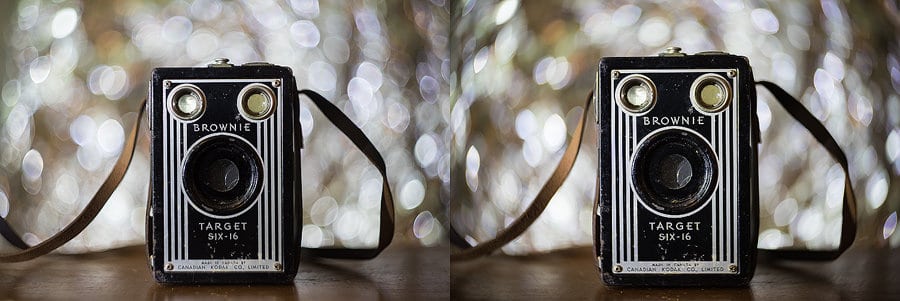
Swirly Blur
So, which lens creates the very bestest, swirliest blur? I'm on the fence, to be honest. The Lensbaby Twist 60 definitely creates the more pronounced effect, but I must confess that I often find the bokeh produced by the Helios 44-2 a little bit more pleasing. Once they are stopped down to f/2.8 or higher, they are virtually indistinguishable. Which do you prefer? In all of my examples, the Helios is on the left and the Lensbaby is on the right. Let me know your thoughts and preferences in the comments, below.
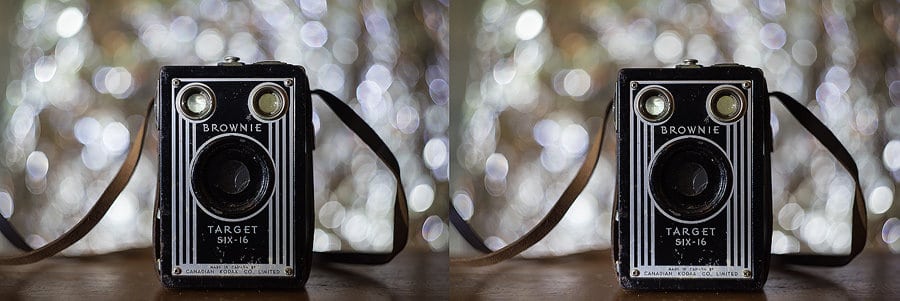
Tangent
If you'll indulge me in a brief tangent…I was dissatisfied with the results I was getting in trying to take comparison photos outside. The light kept changing in the time it took me to change lenses, the wind was blowing, the dogs would not sit still and allow me to get any useable photos of them. I decided I would have to set up indoors, but I was pet sitting out of town and did not have any lights or backdrops. A plain wall wouldn't do for this experiment because I needed lights to create the bokeh I was trying to compare. Fortunately, I remembered an excellent article that was published on Improve Photography last year, about creating inexpensive backdrops. It mentions using crumpled tin foil to create a bokeh background, and voila! It worked like a charm. I didn't have any strobes or speedlights with me, so I just set a flashlight on the couch, pointing at the tinfoil. This was a super easy, 5 minute setup that could be done anywhere.
Recap
Lensbaby Twist 60
- Mount
- Consistency/Reliability
- Weight
- Minimum Focusing Distance
Helios 44-2
- Affordability
- Availability
- Build
- Maximum Aperture
Tied
- Manual Focusing
Undecided
- Best Swirly Bokeh
When all is said and done, both of these lenses are fun and inspiring tools that can put a hasty end to a creative rut. While the Lensbaby Twist 60 creates the more pronounced effect, the extreme affordability of the Helios 44-2 means there's absolutely no excuse for not having it in your bag. I didn't really think I would have any need for both lenses, but now that I've seen the subtle differences, I love them both and wouldn't want to give either of them up. (Yes, I'm a gear hoarder).
For more tips on using your swirly blur lens of choice to its best effect, check out some of the free tutorials on Lensbaby University.

Inspired, I just ordered a 44-2.
You won’t regret it. I love mine…I regret promising it to my niece because I thought it would be too similar to the Twist 60 to keep both. Now I may have to order another!
I love the helios. I think the more subtle swirl is less jarring.
Then you would probably love the new Lensbaby Burnside 35 that I reviewed just this week. At first, I was a little disappointed with the subtlety, but it has really grown on me. It makes it a much more versatile lens.